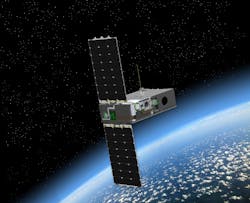Danbury Mission Technologies to develop reconnaissance satellite electro-optical payload for DARPA Blackjack
ARLINGTON, Va. – U.S. military researchers needed a company to develop bus and electro-optical payload for a two satellite on-orbit demonstration of small, secure, and affordable military satellites. They found their solution from Danbury Mission Technologies LLC in Danbury, Conn.
Officials of the U.S. Defense Advanced Research Projects Agency (DARPA) in Arlington, Va., announced $42.9 million contract to Danbury last Friday for phase two of the Blackjack program that seeks to orbit a constellation of small, secure, and affordable military satellites that capitalize on modern commercial satellite technologies.
Blackjack seeks to develop low-cost space payloads and commoditized satellite buses with low size, weight, power, and cost (SWaP-C) with similar capabilities to today’s military communications that operate at geosynchronous orbit (GEO), but at a fraction of the cost.
Danbury Mission Technologies specializes in tactical intelligence, surveillance, and reconnaissance satellites; electro-optical satellite payloads, optical subsystems; and launch vehicle and satellite electronics.
Danbury joins other companies working with DARPA on Blackjack phase two that include Systems & Technology Research LLC in Woburn Mass.; SA Photonics Inc. in Los Gatos, Calif.; the Northrop Grumman Corp. Mission Systems segment in Linthicum, Md.; and Blue Canyon Technologies Inc. in Boulder Colo.
Military satellites are critical to U.S. warfighting capabilities. Traditionally they are placed in GEO to deliver persistent overhead access to any point on the globe.
Yet in the increasingly contested space environment, these costly and monolithic systems are vulnerable targets that would take years to replace if degraded or destroyed. Moreover, their long development schedules make it difficult or impossible to respond quickly to new threats.
The Blackjack program seeks to develop enabling technologies for a global high-speed network backbone in LEO that enables networked, resilient, and persistent military payloads that provide infinite over-the-horizon sensing, signals, and communications capabilities.
Historically, U.S. Department of Defense (DOD) satellites have been custom-designed, with lengthy and expensive design and upgrade cycles. The evolution of commercial space, however, has led to LEO broadband Internet communications satellites that could offer attractive economies of scale.
The Blackjack program emphasizes a commoditized bus and low-cost interchangeable payloads with short design cycles and frequent technology upgrades, based on a ‘good enough’ payloads optimized for more than one type of bus.
Commoditized satellite buses based on open-architecture electrical, software, and mesh network interface control could provide a way for dozens or hundreds of different types of military satellite payloads to operate in low-Earth orbit, DARPA officials say.
The Blackjack program has three primary objectives:
-- develop payload and mission-level autonomy software with on-orbit distributed decision processors that can operate autonomously with on-orbit data processing, and perform shared tasks on-orbit;
-- use advanced commercial manufacturing for military payloads and the spacecraft bus, including high-rate manufacturing using commercial off-the-shelf (COTS)-like parts, reduced screening and acceptance testing for individual spacecraft, and reduced expectations for spacecraft life; and
-- demonstrating satellite payloads in LEO that operate on par with current GEO systems with the spacecraft at costs of less than $6 million per satellite.
To reduce integration risk, Blackjack is developing an avionics unit called Pit Boss for each spacecraft with high-speed processor and encryption devices that will function as a common network and electrical interface. In charge of Pit Boss design is SEAKR Engineering Inc. in Centennial, Colo.
Not only will Pit Boss provide a common electrical interface to each payload, but it also will provide mission level autonomy functions, enable on-orbit edge computing, manage communication between Blackjack satellites and ground users, provide a command and telemetry link to the bus, and encrypt payload data.
Every Blackjack satellite will consist of one commoditized bus capable of broadband rate global communications to other nodes, one Pit Boss control unit, and one or more military payloads that can operate autonomously for more than 24 hours.
The goal is to develop a 60-to-200-satellite constellation operating at altitudes of between 310.7 miles and 807.8 miles above the Earth’s surface. One operations center will cover all government satellites and payloads, and the constellation will be able to operate without the operations center for 30 days. Blackjack payload data processing will be performed on-orbit without the assistance of ground data processing.
The program's three phases are: defining bus and payload requirements; developing bus and payloads for a two satellite on-orbit demonstration; and demonstrating a two-plane system in low-Earth orbit for six months. A future Blackjack demonstration constellation will involve 20 spacecraft in two planes with one or more payloads on each satellite.
For more information contact Danbury Mission Technologies online at www.dmtllc.org, or DARPA at www.darpa.mil.
About the Author
John Keller
Editor-in-Chief
John Keller is the Editor-in-Chief, Military & Aerospace Electronics Magazine--provides extensive coverage and analysis of enabling electronics and optoelectronic technologies in military, space and commercial aviation applications. John has been a member of the Military & Aerospace Electronics staff since 1989 and chief editor since 1995.
